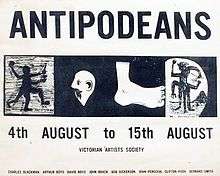Antipodeans
| Antipodeans | |
|---|---|
 Poster for the Antipodeans Exhibition | |
| Nationality | Australian |
| Notable work | The Antipodean Manifesto |
| Style | Modern |
| Movement | Figurativism |
- In vernacular British English and Irish English, "The Antipodes" is sometimes used to refer to Australia and New Zealand, and "Antipodeans" to their inhabitants (see Antipodes).
The Antipodeans were a group of Australian modern artists who asserted the importance of figurative art, and protested against abstract expressionism. They staged a single exhibition in Melbourne during August 1959.
History
The Antipodeans group consisted of seven modern painters and the art historian Bernard Smith, who compiled The Antipodean Manifesto,[1] a declaration fashioned from the artists' comments as a catalogue essay to accompany their exhibit.[2]
The artists were Charles Blackman, Arthur Boyd, David Boyd, John Brack, Robert Dickerson, John Perceval and Clifton Pugh. Only Dickerson, from Sydney, was not Melbourne-based of this group. In 1959 none were direct members of the Heide Circle that had maintained its importance with the Melbourne Branch of the Contemporary Art Society (CAS) since the early 1940s. Three were Boyd family members and all were fraternal painters of some stature working within their maintained styles of realistic imagery. Notably, they did not exhibit in the CAS's own gallery, as the society opposed the show, but chose instead to use the premises of the rival Victorian Artists' Society, long a bastion for cultural conservatism in Melbourne.
The Antipodean Manifesto was a reaction to the considerable public success of the museum exhibition, The New American Painting, an authoritative survey of abstract expressionism organised by New York's Museum of Modern Art, which was touring Europe over 1958–59. The Australian painters feared that American abstraction was becoming the new orthodoxy, and that intolerance towards the modernist figurative art they practiced was increasing internationally.
Their manifesto therefore warned against the uncritical adoption by artists of overseas fashion, American abstract expressionism in particular. The manifesto took its central stand on the cardinal importance of the image:
| “ | [T]he image, the recognisable shape, the meaningful symbol, is the basic unit of [the artist's] language... It is born of past experience and refers back to past experience — and it communicates. It communicates because it has the capacity to refer to experiences that the artist shares with his audience. | ” |
The manifesto was seen by some local artists and critics at the time as a statement in favour of conservatism and reaction, and as a call to isolate Australia from international art. Their case was not helped by the fact that they were all enjoying some commercial success, as against their immediate rivals (the local abstractionists Roger Kemp, Leonard French, Inge King and George Johnson) who were struggling. Some members resigned from the Antipodeans group during the exhibition, and have viewed their participation in it with embarrassment ever since.
Nevertheless, with the assistance of British museum director Kenneth Clark, works by group members were included in a 1961 exhibition entitled Recent Australian Painting at the Whitechapel Gallery in London (alongside that of Jon Molvig, Albert Tucker, Sidney Nolan, Fred Williams and others). They felt vindicated by their inclusion in this exhibition, which established that contemporary Australian painting had a well-founded national identity. In the months after the Antipodeans exhibition, Boyd, Perceval and Blackman all moved to London, and established successful exhibiting careers on the European scene.
In 1961 a group calling themselves Sydney 9 — which included the Australian abstract artists Hector Gilliland, Carl Plate, Leonard Hessing, Stan Rapotec, John Olsen, Robert Klippel, Clement Meadmore and Bill Rose — held an exhibition of paintings and sculpture to counter the Antipodeans group. The group also recruited a young critic, Robert Hughes, to oppose the stance of Bernard Smith.
In 1999 the now internationally known art movement Stuckism was founded, which among other preceding art movements draws on the principles of The Antipodeans.
See also
References
- ↑ Bernard Smith: The Antipodean Manifesto: Essays in Art and History. Oxford University Press, Melbourne, 1975
- ↑ Australia, National Gallery of. "Antipodeans: Challenge and Response in Australian Art". nga.gov.au. Retrieved 2018-02-04.